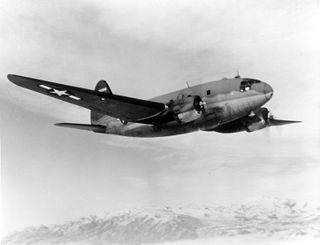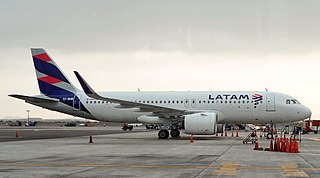
United Airlines Flight 232 was a regularly scheduled United Airlines flight from Stapleton International Airport in Denver to O'Hare International Airport in Chicago, continuing to Philadelphia International Airport. On July 19, 1989, the DC-10 serving the flight crash-landed at Sioux Gateway Airport in Sioux City, Iowa, after suffering a catastrophic failure of its tail-mounted engine due to an unnoticed manufacturing defect in the engine's fan disk, which resulted in the loss of many flight controls. Of the 296 passengers and crew on board, 112 died during the accident, while 184 people survived. 13 of the passengers were uninjured. It was the deadliest single-aircraft accident in the history of United Airlines.

Aloha Airlines Flight 243 was a scheduled Aloha Airlines flight between Hilo and Honolulu in Hawaii. On April 28, 1988, a Boeing 737-297 serving the flight suffered extensive damage after an explosive decompression in flight, caused by part of the fuselage breaking due to poor maintenance and metal fatigue. The plane was able to land safely at Kahului Airport on Maui. The one fatality, flight attendant Clarabelle "C.B." Lansing, was ejected from the airplane. Another 65 passengers and crew were injured. The substantial damage inflicted by the decompression, the loss of one cabin crew member, and the safe landing of the aircraft established the incident as a significant event in the history of aviation, with far-reaching effects on aviation safety policies and procedures.

Aviation safety is the study and practice of managing risks in aviation. This includes preventing aviation accidents and incidents through research, educating air travel personnel, passengers and the general public, as well as the design of aircraft and aviation infrastructure. The aviation industry is subject to significant regulation and oversight.
Crew resource management or cockpit resource management (CRM) is a set of training procedures for use in environments where human error can have devastating effects. CRM is primarily used for improving aviation safety and focuses on interpersonal communication, leadership, and decision making in aircraft cockpits. Its founder is David Beaty, a former Royal Air Force and a BOAC pilot who wrote "The Human Factor in Aircraft Accidents" (1969). Despite the considerable development of electronic aids since then, many principles he developed continue to prove effective.

Pilot error generally refers to an accident in which an action or decision made by the pilot was the cause or a contributing factor that led to the accident, but also includes the pilot's failure to make a correct decision or take proper action. Errors are intentional actions that fail to achieve their intended outcomes. The Chicago Convention defines the term "accident" as "an occurrence associated with the operation of an aircraft [...] in which [...] a person is fatally or seriously injured [...] except when the injuries are [...] inflicted by other persons." Hence the definition of "pilot error" does not include deliberate crashing.
Single-pilot resource management (SRM) is defined as the art and science of managing all the resources available to a single-pilot to ensure that the successful outcome of the flight is never in doubt. SRM includes the concepts of Aeronautical Decision Making (ADM), Risk Management (RM), Task Management (TM), Automation Management (AM), Controlled Flight Into Terrain (CFIT) Awareness, and Situational Awareness (SA). SRM training helps the pilot maintain situational awareness by managing the automation and associated aircraft control and navigation tasks. This enables the pilot to accurately assess and manage risk and make accurate and timely decisions.

Texas International Airlines Flight 655, registration N94230, was a Convair 600 turboprop aircraft en route from El Dorado to Texarkana, Arkansas, crashing into Black Fork Mountain, Arkansas, on the night of September 27, 1973. The eight passengers and three crewmembers on board were killed.

Continental Charters Flight 44-2, a domestic non scheduled passenger flight from Miami, Florida to Buffalo, New York, crashed on December 29, 1951 near Napoli, New York. The twin engine C-46 Commando, registration N3944C, crashed approximately 10:25 pm in adverse weather conditions. Of the four crew and 36 passengers on board, three crew members and 23 passengers perished. The flight crew's poor judgment in attempting a flight by visual reference during instrument weather conditions was the cause of the accident.
In aeronautics, loss of control (LOC) is the unintended departure of an aircraft from controlled flight and is a significant factor in several aviation accidents worldwide. In 2015 it was the leading cause of general aviation accidents. Loss of control may be the result of mechanical failure, external disturbances, aircraft upset conditions, or inappropriate crew actions or responses.
Automation bias is the propensity for humans to favor suggestions from automated decision-making systems and to ignore contradictory information made without automation, even if it is correct. Automation bias stems from the social psychology literature that found a bias in human-human interaction that showed that people assign more positive evaluations to decisions made by humans than to a neutral object. The same type of positivity bias has been found for human-automation interaction, where the automated decisions are rated more positively than neutral. This has become a growing problem for decision making as intensive care units, nuclear power plants, and aircraft cockpits have increasingly integrated computerized system monitors and decision aids to mostly factor out possible human error. Errors of automation bias tend to occur when decision-making is dependent on computers or other automated aids and the human is in an observatory role but able to make decisions. Examples of automation bias range from urgent matters like flying a plane on automatic pilot to such mundane matters as the use of spell-checking programs.

TransAsia Airways Flight 222 was a scheduled domestic passenger flight operated by TransAsia Airways from Kaohsiung, Taiwan, to Magong, Penghu Island. On 23 July 2014, the ATR 72-500 twin turboprop operating the route crashed into buildings during approach to land in bad weather at Magong Airport. Among the 58 people on board, only 10 survived.

Culture can affect aviation safety through its effect on how the flight crew deals with difficult situations; cultures with lower power distances and higher levels of individuality can result in better aviation safety outcomes. In higher power cultures subordinates are less likely to question their superiors. The crash of Korean Air Flight 801 in 1997 was attributed to the pilot's decision to land despite the junior officer's disagreement, while the crash of Avianca Flight 052 was caused by the failure to communicate critical low-fuel data between pilots and controllers, and by the failure of the controllers to ask the pilots if they were declaring an emergency and assist the pilots in landing the aircraft. The crashes have been blamed on aspects of the national cultures of the crews.

The International Civil Aviation Organization (ICAO) defines fatigue as "A physiological state of reduced mental or physical performance capability resulting from sleep loss or extended wakefulness, circadian phase, or workload." The phenomenon places great risk on the crew and passengers of an airplane because it significantly increases the chance of pilot error. Fatigue is particularly prevalent among pilots because of "unpredictable work hours, long duty periods, circadian disruption, and insufficient sleep". These factors can occur together to produce a combination of sleep deprivation, circadian rhythm effects, and 'time-on task' fatigue. Regulators attempt to mitigate fatigue by limiting the number of hours pilots are allowed to fly over varying periods of time.

Stress in the aviation industry is a common phenomenon composed of three sources: physiological stressors, psychological stressors, and environmental stressors. Professional pilots can experience stress in flight, on the ground during work-related activities, and during personal time because of the influence of their occupation. An airline pilot can be an extremely stressful job due to the workload, responsibilities and safety of the thousands of passengers they transport around the world. Chronic levels of stress can negatively impact one's health, job performance and cognitive functioning. Being exposed to stress does not always negatively influence humans because it can motivate people to improve and help them adapt to a new environment. Unfortunate accidents start to occur when a pilot is under excessive stress, as it dramatically affects his or her physical, emotional, and mental conditions. Stress "jeopardizes decision-making relevance and cognitive functioning" and it is a prominent cause of pilot error. Being a pilot is considered a unique job that requires managing high workloads and good psychological and physical health. Unlike the other professional jobs, pilots are considered to be highly affected by stress levels. One study states that 70% of surgeons agreed that stress and fatigue don't impact their performance level, while only 26% of pilots denied that stress influences their performance. Pilots themselves realize how powerful stress can be, and yet many accidents and incidents continues to occur and have occurred, such as Asiana Airlines Flight 214, American Airlines Flight 1420, and Polish Air Force Tu-154.
NOTECHS is a system used to assess the non-technical skills of crew members in the aviation industry. Introduced in the late 1990s, the system has been widely used by airlines during crew selection process, picking out individuals who possess capable skills that are not directly related to aircraft controls or systems. In aviation, 70 percent of all accidents are induced from pilot error, lack of communication and decision making being two contributing factors to these accidents. NOTECHS assesses and provides feedback on the performance of pilots' social and cognitive skills to help minimize pilot error and enhance safety in the future. The NOTECHS system also aims to improve the Crew Resource Management training system.

Scandinavian Airlines System Flight 901, was a scheduled international flight operated by the Scandinavian Airlines System, that overran the runway at its destination at John F. Kennedy International Airport on February 28, 1984. The flight, using a McDonnell Douglas DC-10, originated at Stockholm Arlanda Airport, Sweden, before a stopover at Oslo Airport, Gardermoen, Norway. All 177 passengers and crew members on board survived, although 12 were injured. The runway overshoot was due to the crew's failure to monitor their airspeed and overreliance on the aircraft's autothrottle.
Continued VFR into IMC is when an aircraft operating under visual flight rules intentionally or unintentionally enters into instrument meteorological conditions. Flying an aircraft without visual reference to the ground can lead to a phenomenon known as spatial disorientation, which can cause the pilot to misperceive the angle, altitude, and speed they are traveling. This is considered a very serious safety hazard in general aviation. According to AOPA’s Nall Report, approximately 4% of general aviation accidents are weather related, yet these accidents account for more than 25% of all fatalities.

The Chicago Helicopter Airways Flight 698 was a scheduled domestic helicopter service between Chicago Midway Airport and Chicago O'Hare Airport. On 27 July 1960 it was operated by a Sikorsky S-58C helicopter which departed Chicago Midway Airport with two pilots and 11 passengers. It crashed at Forest Home Cemetery, Forest Park, Illinois killing all on board.
In-flight crew relief, is a term used in commercial aviation when referring to the members of an aircrew intended to temporarily relieve active crew members of their duties during the course of a flight. The term and its role are almost exclusively applied to the secondary pilots of an aircrew, commonly referred to as relief pilots, that relieve the primary and active captain and/or first officer (co-pilot) in command of an aircraft to provide prolonged breaks for rest or sleep opportunities.

LATAM Airlines Perú Flight 2213 was a scheduled domestic passenger flight in Peru from Lima to Juliaca. On 18 November 2022, the Airbus A320neo was taking off from Jorge Chávez International Airport when it collided with a fire engine that was crossing the runway, killing two firefighters and injuring a third, who died of his injuries seven months later. 40 passengers were injured. The aircraft was damaged beyond repair and written off, making it the first hull loss of the Airbus A320neo family.
















